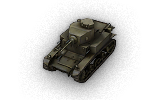M3 Light
M3_Stuart_LL (Stock)
Totals
| 850 Koszt |
| 330 PWWytrzymałość |
| 12.01 / 12.5 Masa |
Crew
- Dowódca
- Ładowniczy
- Strzelec
- Radiowiec
- Kierowca
Armor
| 38/25/25Pancerz kadłuba(przód/boki/tył, mm) |
| 38/25/25Pancerz wieży(przód/boki/tył, mm) |
Maneuver
| 268 KMMoc silnika |
| 61 km/hPrędkość maksymalna/cofania |
| 40 stopni/sPrędkość obrotu |
Firepower
| 40 damage |
| 48 mmŚrednia penetracja |
| 3.2 Czas pełnego przeładowania |
| 40 stopni/sPrędkość obrotu działa |
Communication
| 210 mZasięg widzenia |
| 500 mZasięg sygnału |
M3 Light
III

850
It was previously available to new players for completing the in-game training course. It's slightly better than a stock M3 Stuart, but inferior to one that's been fully upgraded. Even so, don't underestimate this tank, as it still has decent top speed and a fast-firing cannon.


Wieża
| Poziom | Wieża | Pancerz wieży (przód/boki/tył, mm) | Prędkość obrotu działa (stopni/s) | Zasięg widzenia (m) | Doświadczenie | Masa (t) |
|---|---|---|---|---|---|---|
| II | D37812 | 38/25/25 | 40 | 210 | 0 | 1250 |
| Poziom | Działo | Średnia penetracja (mm) | Szybkostrzelność | Celność na 100 m | Czas celowania | Doświadczenie | Masa (t) | |
|---|---|---|---|---|---|---|---|---|
| II | 37 mm M5 | 48/70/19 | 40/40/50 | 18.75 | 0.36 | 1.7 | 0 | 78 |

Silnik
| Poziom | Silnik | Moc silnika (KM) | Prawdopodobieństwo pożaru przy trafieniu | Doświadczenie | Masa (t) |
|---|---|---|---|---|---|
| IV | Continental W-670 | 268 | 20 | 0 | 256 |

| Poziom | Zawieszenie | Maks. obciążenie | Prędkość obrotu (stopni/s) | Doświadczenie | Masa (t) |
|---|---|---|---|---|---|
| II | Stuart E1 | 12.5 | 40 | 0 | 3000 |

Radio
| Poziom | Radio | Zasięg sygnału (m) | Doświadczenie | Masa (t) |
|---|---|---|---|---|
| IV | SCR_209 | 500 | 0 | 80 |
Compatible Equipment
Compatible Consumables
Player Opinion
Pros and Cons
Pros:
- Excellent top speed
- Good turret traverse speed and elevation arc
- Good rate of fire
- Very good frontal armor for light tank, immune to most machineguns and autocannons (except weak spots like driver's hatch)
- Does not encounter tier 5 battles, unlike the regular Stuart
Cons:
- Poor damage and penetration
- Poor view and signal range
Performance
The short signal range makes it less beneficial as a scout than it otherwise could be. However, it is a effective flanker, and it has a fast firing cannon but low penetration, so shooting at the sides of enemy tanks in a must.
Historical Info
From the summer of 1942, when enough US medium tanks had been received, the British usually kept Stuarts out of tank-to-tank combat, using them primarily for reconnaissance. The turret was removed from some examples to save weight and improve speed and range. These became known as "Stuart Recce". Some others were converted to armored personnel carriers and were known as "Stuart Kangaroo", and some were converted command vehicles and known as "Stuart Command". M3s, M3A3s, and M5s continued in British service until the end of the war, but British units had a smaller proportion of these light tanks than US units. The other major Lend-Lease recipient of the M3, the Soviet Union, was even less happy with the tank, considering it undergunned, underarmored, likely to catch fire, and too sensitive to fuel quality. The narrow tracks were highly unsuited to operation in winter conditions, as they resulted in high ground pressures under which the tank sank into the snow. Further, the M3's radial aircraft engine required high-octane fuel, which complicated Soviet logistics as most of their tanks used diesel. However, the M3 was superior to early-war Soviet light tanks such as the T-60, which were often underpowered and possessed even lighter armament than the Stuart. In 1943, the Red Army tried out the M5 and decided that the upgraded design was not much better than the M3. Being less desperate than in 1941, the Soviets turned down an American offer to supply the M5. M3s continued in Red Army service at least until 1944.
| Light Tanks | |
| Medium Tanks | |
| Heavy Tanks | |
| Tank Destroyers | |
| Self-Propelled Artillery |
| USA | |
| UK | |
| Germany | |
| USSR | |
| China | |
| Japan |